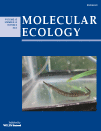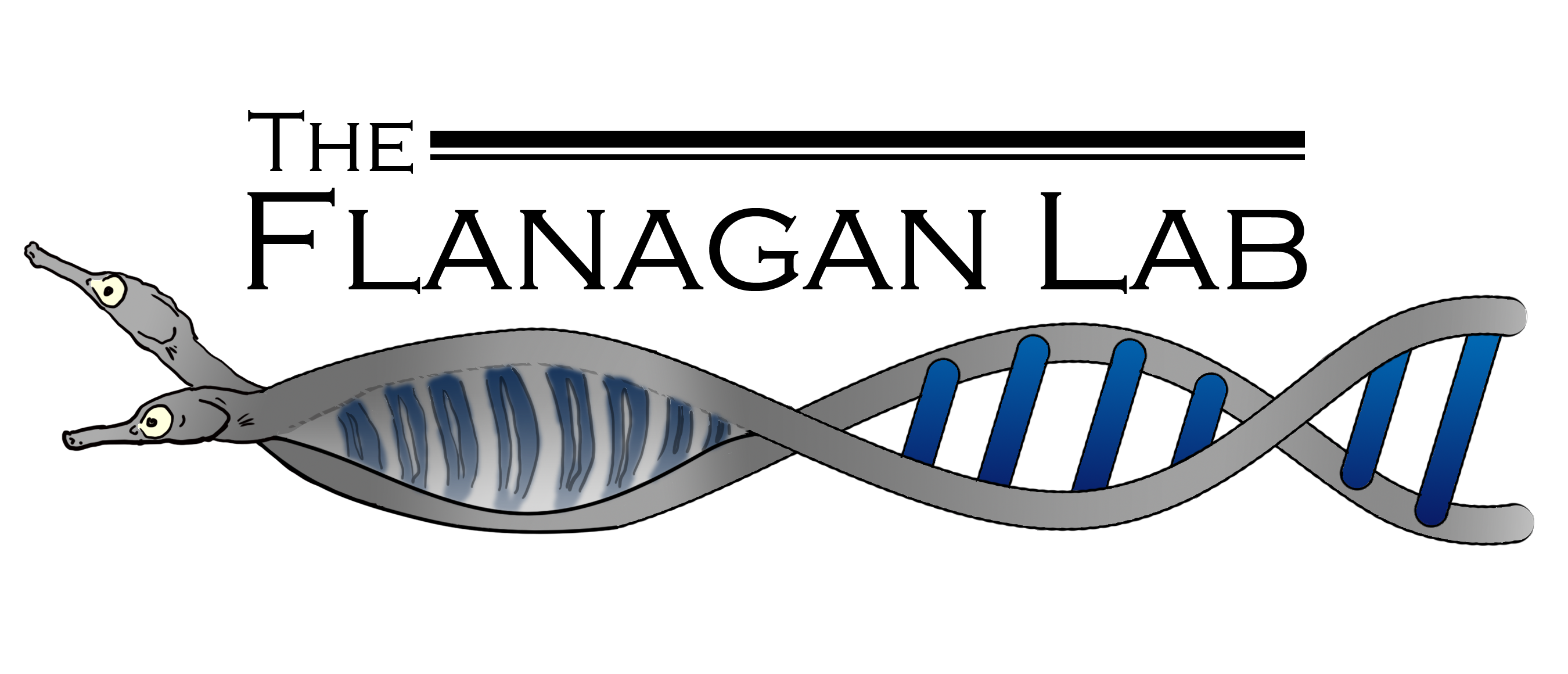Publications
Authors whose names are in green are trainees supervised by Sarah. Co-first authorship is denoted by *.
Peer-reviewed papers
- Flanagan SP, Alonzo SH. (2024) Supergenes are not necessary to explain the maintenance of complex alternative phenotypes. Proceedings of the Royal Society B. 291: 20241715. link to paper, PDF, supplemental material, shiny app to inspect model conditions, associated code
- Tosto N, Rose E, Mason H, Mank J, Flanagan SP (2024) Sexual selection on non-ornamental traits is underpinned by evidence of genetic constraints on sex-biased expression in dusky pipefish. Molecular Ecolology e17550. link to paper, PDF
- van Eyndhoven F, Cameron EZ, Flanagan SP. (2023) High rates of male courtship in a female-ornamented pipefish. The Royal Society Open Science. 10: 231428. 231428.link to paper, PDF, associated code, data, article in The Conversation about the research
- Tosto NM, Rose E, Flanagan SP, Mason HD. (2023) The development of a quantification method for measuring iridescence using sexually selected traits in the Gulf pipefish (Syngnathus scovelli). Frontiers in Marine Science. 10: 1127790 link to paper, PDF
- Tosto NM, Beasley ER, Wong BBM, Mank JE, Flanagan SP (2023) The roles of sexual selection and sexual conflict in shaping patterns of genome and transcriptome variation. Nature Ecology & Evolution. https://doi.org/10.1038/s41559-023-02019-7. link to paper
- Johnson BD, Anderson AP, Small CM, Rose E, Flanagan SP, Hendrickson-Rose C, and Jones AG (2022) The evolution of the testis transcriptome in pregnant male pipefishes and seahorses. Evolution. DOI: 10.1111/evo.14579. link to paper, PDF
- Pullen M, Gerber D, Thomsen MS, Flanagan SP (2022) Seasonal dynamics of faunal diversity and population ecology in an estuarine seagrass bed. Estuaries and Coasts. DOI: 10.1007/s12237-022-01103-8. link to paper (open access), PDF, associated code, data, my summary, a one-page summary
- Howell LA, LaRue M, Flanagan SP (2021) Environmental DNA as a tool for monitoring Antarctic vertebrates. New Zealand Journal of Zoology. DOI: 10.1080/03014223.2021.1900299. link to paper, PDF, my summary
- Flanagan SP, Rose E, Jones AG (2021) The population genomics of repeated freshwater colonizations by Gulf pipefish. Molecular Ecology. DOI: 10.1111/mec.15841 link to paper, PDF
- Anderson AP, Flanagan SP, Rose E, Jones AG. 2020. The estrogen-responsive transcriptome of female secondary sexual traits in the Gulf pipefish, Journal of Heredity, esaa008, link to paper, AGA's blog post about the paper
- Lerch B, Dautel KA, Brewer S, Liang A, Siewe N, Flanagan SP. 2020. Space, density, and extra-pair matings have opposing impacts on male and female reproductive success. Population Ecology. link to paper, PDF
- Wright AM, Schwartz RS, Oaks JR, Newman CE, Flanagan SP. The why, when, and how of computing in biology classrooms [version 2; peer review: 2 approved]. F1000Research 2019, 8:1854. link to paper (open access)
- Flanagan SP, and Jones AG. 2019. The future of parentage analysis: Moving from microsatellites to SNPs and beyond. Molecular Ecology. 28(3): 544-567 doi: 10.1111/mec.14988 link to paper, my summary
- Jost L, Archer F, Flanagan SP, Gaggiotti O, Hoban S, Latch E. 2018. Differentiation measures for conservation genetics. Evolutionary Applications. 11: 1139-1148. doi: 10.1111/eva.12590. pdf, link to paper, my summary
- , , , , . 2017. Guidelines for planning genomic assessment and monitoring of locally adaptive variation to inform species conservation. Evolutionary Applications. 11: 1035–1052. doi: 10.1111/eva.12569. pdf, link to paper, my summary
- Flanagan SP, and Jones AG. 2017. Substantial differences in bias between single-digest and double-digest RAD-seq: A case study. Molecular Ecology Resources. 18:264–280. doi: 10.1111/1755-0998.12734. link to paper, my summary, associated code, gwscaR, data, genomic data
- Flanagan SP, and Jones AG. 2017. Constraints on the FST-heterozygosity outlier approach. Journal of Heredity. 108(5): 561-573. doi: 10.1093/jhered/esx048 pdf, link to paper, my summary, associated code, data
- Flanagan SP, and Jones AG. 2017. Genome-wide selection components analysis in a fish with male pregnancy. Evolution. 71: 1096–1105. DOI: 10.1111/evo.13173 pdf, link to paper, my summary, associated code, data, genomic data
- Flanagan SP, Rosenqvist G, and Jones AG. 2017. Mate quality and timing of reproduction affects sexual selection in a sex-role-reversed pipefish. Behavioral Ecology and Sociobiology. 71(1): 1-10. doi: 10.1007/s00265-016-2255-3 pdf, link to paper, press release, data
 Flanagan SP, Rose E, and Jones AG. 2016. Population genomics reveals multiple drivers of population differentiation in a sex-role-reversed pipefish. Molecular Ecology. 25(20): 5043-5072. doi: 10.1111/mec.13794 pdf, link to paper, my summary, data, genomic data, associated code
Flanagan SP, Rose E, and Jones AG. 2016. Population genomics reveals multiple drivers of population differentiation in a sex-role-reversed pipefish. Molecular Ecology. 25(20): 5043-5072. doi: 10.1111/mec.13794 pdf, link to paper, my summary, data, genomic data, associated code- Titon SCM, de Assis VR, Titon Jr B, Barsotti AMG, Flanagan SP, and Gomes FR. 2016. Calling rate, corticosterone plasma levels and immunocompetence of Hypsiboas albopunctatus. Comparative Biochemistry and Physiology: Part A. 201: 53-60. link to paper
- Rose E, Flanagan SP, and Jones AG. 2015. The effects of synthetic estrogen on the sexually dimorphic liver transcriptome of the sex-role-reversed Gulf pipefish. PLoS One. 10(10): e0139401. pdf, my summary, associated code
- Flanagan SP, and Jones AG. 2015. Identifying signatures of sexual selection using genome-wide selection components analysis. Ecology and Evolution. 5(13): 2722-2744. doi: 10.1002/ece3.1546. link to paper, pdf, my summary, data, associated code
- Flanagan SP, Johnson JB, Rose E, and Jones AG. 2014. Sexual selection on female ornaments in the sex-role-reversed Gulf pipefish (Syngnathus scovelli). Journal of Evolutionary Biology. 27 (11): 2457-2467. pdf, data
- Flanagan SP, and Bevier CR. 2014. Do male activity and territory quality affect female association time in the Brown Anole, Anolis sagrei? Ethology. 120 (4): 365-374. link to paper
- Flanagan SP, Wilson WH, Jones KL, and Lance SL. 2010. Development and characterization of twelve polymorphic microsatellite loci in the Bog Copper, Lycaena epixanthe. Conservation Genetics Resources. 2(1): 159-161. pdf
Other outputs
- Flanagan SP 2023. Male pregnancy and weird courtship wiggles: how NZ’s wide-bodied pipefish confounds expectations. The Conversation. link
- Thomsen M, Moser A, Pullen M, Gerber D, & Flanagan SP . 2020. Seagrass beds provide habitat for crabs, shrimps and fish in two estuaries on the South Island of New Zealand. bioRxiv. link to paper, PDF
- Flanagan, SP 2019. Quantitative Genetics of Behavior. In: Choe, J.C. (Ed.), Encyclopedia of Animal Behavior, (2nd ed.). vol. 2, pp. 80–93. Elsevier, Academic Press. link to paper, PDF
- Flanagan SP. 2017. Pipefish pairing. Biosphere Magazine. 23. PDF (opens in a new tab)
Theses
- O'Neill, R. 2023. Quantifying the reproductive ecology and immune-related gill gene regulation in Stigmatopora macropterygia. link
- Cox, A. 2023. Insight into the effectomes of Aotearoa Phythophthora cinnamomi isolates by comparative genomics. link
- van Eyndhoven, F. 2022. The role of the novel female ornament in the wide-bodied pipefish, Stigmatapora nigra. http://dx.doi.org/10.26021/12821 link
- Howell, L. 2021. Detecting Antarctic and New Zealand vertebrates using environmental DNA (eDNA). http://dx.doi.org/10.26021/10882. link
- Gerber, DA (co-supervised by [Mads Thomsen](https://www.thomsenlab.com/)). 2021. Associations between estuarine foundation species and their effect on biodiversity across latitudes and seasons. http://dx.doi.org/10.26021/11369 link
- Pullen, M. 2021. The use of seagrass (Zostera muelleri) habitat types by seagrass communities in New Zealand. http://dx.doi.org/10.26021/11188. link
***Please contact me if you require access to a PDF***
